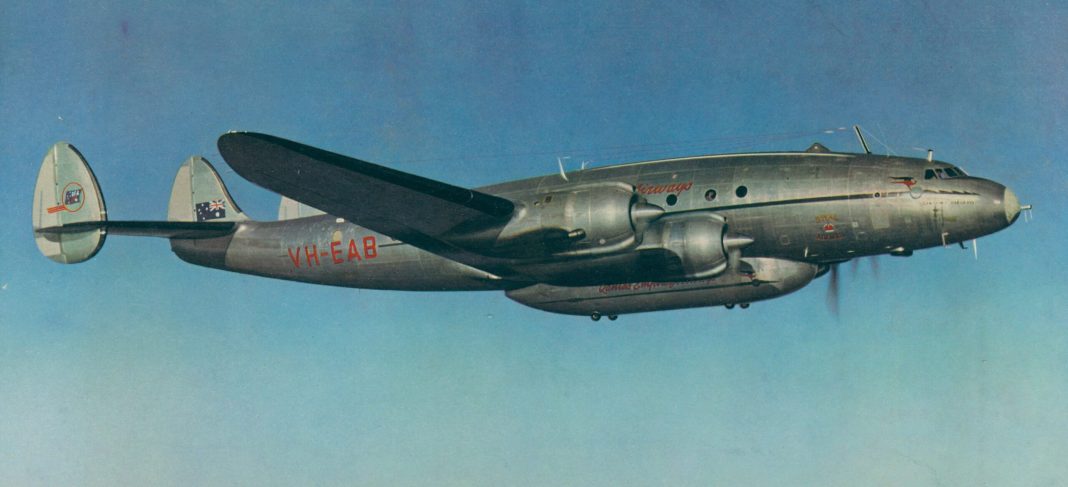When Qantas began flying the Kangaroo Route in 1947, it used Lockheed Constellations. Onboard were ten crew, including three pilots, one navigator, one radio operator,
two flight engineers, and three cabin crew. They looked after just 29 passengers who paid the equivalent of US$26,000 to fly from Sydney to London. Travel time was around 58 hours.

It was called the Kangaroo Route because the flight hopped its way across to London. In those early days, there were seven stops, a rollcall of interesting cities. After departing from Sydney, the Constellation stopped at Darwin, Singapore, Calcutta, Karachi, Cairo, Castel Benito, Rome, and finally, London.
Stay informed: Sign up for our daily aviation news digest.
Multiple stops over multiple days
Qantas was flying to London before 1947 – sort of. As a forerunner to today’s code sharing and airline alliance deals, throughout much of the 1940s, Qantas would fly you to Ceylon and, later, Karachi to connect with BOAC for the remainder of the journey.
Over the next decade, Qantas tinkered with the route. Despite the cost, the airline was running multiple services a week each way. Cities like Frankfurt, Zürich, Rome, Belgrade, Athens, Beirut, Tehran, Bombay, and Colombo came into the mix as other cities dropped off the run.
Within a decade, there were multiple competitors on the route. BOAC was running four Britannias a week in each direction. Air India had a weekly Super Constellation service between Sydney and London. KLM ran a Super Constellation between Sydney and Amsterdam. Whether Sydney – Amsterdam actually falls within the Kangaroo Route is debatable, but let’s be generous. You could say the same about the TAI Douglas DC-6B that stopped in Sydney on the run between Auckland and Paris. By this time, Qantas had swapped out its Lockheed Constellations for Super Constellations.

In 1959, Qantas put a jet on the Kangaroo Route, a Boeing 707. By then, Qantas was incorporating the Kangaroo Route into an around the world run. The flights that went towards London via North America flew what was called the Southern Cross Route. The Kangaroo Route label stayed with the flights to London over South Asia and Europe.

The Boeing 747 revolutionized the Kangaroo Route
In the early 1970s, the advent of the Boeing 747 meant big changes on the Kangaroo Route. The days of multiple stops were over. As a little kid, I recall late-night stops in Singapore, Bombay, and Bahrain. They’d open the plane door at 3.00 am in Bombay, and the intense smells of India would fill the plane. I’d look out the window and see lights from the fires still burning at the shanties abutting the airport.
As aircraft got bigger, the stops in places like Bombay ended. The Boeing 747 held an iron grip on the Kangaroo Route well into the 2000s. But by then, there was just one stop, usually in Singapore. And clean, clinical Singapore with its aerobridges and air conditioning, always did a good job keeping the local sights, smells, and noises at bay. More’s the pity.
By 2010, the A380 was the star airline on the Kangaroo Route. Qantas, Singapore Airlines, Malaysia Airlines, THAI, Emirates, Etihad, and Qatar rolled out the big plane on the route. Interestingly, BOAC’s modern-day successor, British Airways, never sent the A380 to Sydney. Other European airlines, such as KLM, all split from Australia back in the 1990s.

These days, when not grounded, Qantas offers the choice of a daily A380 service via Singapore or a daily 787-9 service via Perth. British Airways normally whizzes down to Sydney via Singapore using a Boeing 777. All are a long way from the Lockheed Constellation. That contemporary 787-9 carries almost ten times as many passengers as the Lockheed, and a return ticket typically costs around US$1000. Both routes take about 21 or 22 hours, depending on the winds.
Next on the horizon is flying regularly scheduled services from Sydney to London without stopping. Qantas wants to do it. They probably will in the next five to six years. But without all those hops, should it still be called the Kangaroo Route?
[ad_2]
Source link


